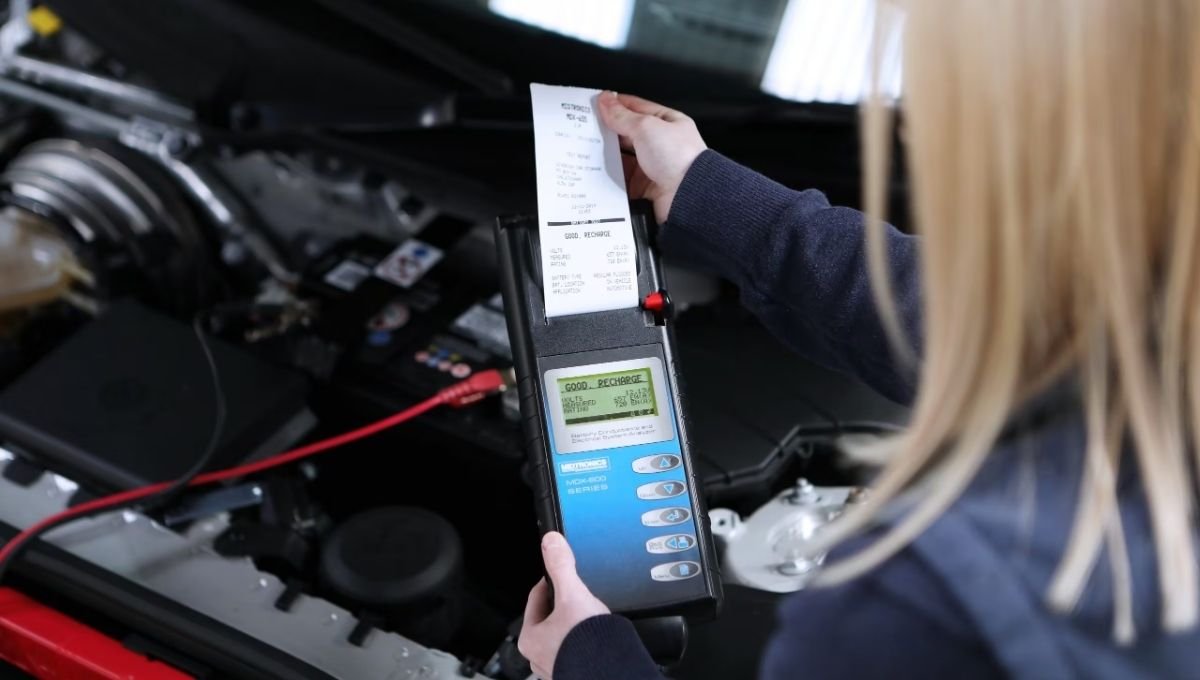Is it Okay to Charge a Car Battery Indoors – Risks and Tips!
Charging a car battery indoors can be convenient but requires careful safety measures. I once charged mine in a garage, making sure to keep it well-ventilated and free from flammable materials.
Regular monitoring and using reliable equipment helped prevent potential hazards. Proper airflow is crucial to avoid risks like hydrogen gas buildup.
Introduction:
Charging a car battery is often viewed as a simple task. However, the environment in which you choose to charge the battery can have a significant impact on safety and efficiency.
While many opt for the convenience of charging indoors—especially during colder months—there are critical considerations to keep in mind.
Understanding whether it’s safe to charge a car battery inside your home or garage is essential for preventing accidents, protecting your property, and ensuring the battery is properly maintained. Let’s explore why the charging location matters and whether indoor charging is truly advisable.
Why Knowing Where to Charge Your Car Battery Matters:

Understanding Car Battery Types and Charging Needs:
Not all car batteries are created equal. The type of battery in your vehicle dictates its specific charging requirements. For instance, lead-acid batteries—common in traditional vehicles—are known to emit hydrogen gas when charged, particularly under overcharging conditions.
On the other hand, newer vehicles with lithium-ion batteries come with different chemical compositions and charging dynamics. These batteries don’t emit hydrogen, but improper charging methods can still pose risks.
Understanding the type of battery you have and its unique needs will help determine if it’s safe to charge indoors and how to minimize risks.
Common Concerns About Charging Locations:
Where you charge a car battery is often dictated by convenience, but there are risks tied to that decision. Indoor spaces—garages, basements, and workshops—often lack sufficient ventilation, which can increase the hazards associated with charging, especially for lead-acid batteries.
Improper ventilation can result in a dangerous buildup of hydrogen gas, potentially leading to an explosion.
There’s also the proximity to flammable materials or electrical equipment to consider, as sparks from faulty connections or overheated chargers can turn a minor mistake into a major disaster. Recognizing these concerns upfront helps in selecting the most appropriate and safe space for charging.
Safety Considerations: Can Charging a Car Battery Indoors Be Dangerous?
The Risk of Hydrogen Gas Emissions: What You Need to Know
When a lead-acid battery charges, it generates hydrogen gas, which is highly flammable. In confined, poorly ventilated areas, even a small concentration of hydrogen can be enough to ignite.
If a charging battery is placed near a source of ignition—such as an electrical outlet, a heater, or a tool that creates sparks—the results can be catastrophic.
Hydrogen is lighter than air, which means it tends to accumulate near the ceiling, making proper ventilation crucial. Ensuring your indoor space has adequate airflow is one way to mitigate this risk, but it’s often not enough on its own.
Electrical Hazards: Reducing the Risk of Sparks or Fire
Beyond the dangers posed by hydrogen gas, charging a battery indoors introduces the potential for electrical mishaps. Chargers with damaged cables, improper connections, or poor-quality electrical outlets can lead to short circuits, sparking, or even fires.
Additionally, improper charging techniques—such as using a charger with the wrong voltage or leaving the battery unattended for long periods—can cause overheating, leading to a fire hazard.
It’s critical to ensure all electrical components are in top condition and that they are used in accordance with the manufacturer’s guidelines.
Ventilation is Key: Avoiding Dangerous Fume Buildup Indoors
Good ventilation is the unsung hero when it comes to safely charging a car battery indoors. Without proper airflow, dangerous fumes like hydrogen can accumulate and create an explosive environment.
Moreover, the heat generated during charging can increase the temperature of enclosed spaces, leading to additional hazards. Whether in a garage or basement, make sure windows are open, fans are running, and the area is clear of any obstructions that could block airflow.
Even if hydrogen buildup isn’t a concern with lithium-ion batteries, proper ventilation helps disperse heat and ensure a safer environment.
Best Practices for Charging a Car Battery Indoors:

Choosing the Right Spot: What Makes a Safe Indoor Charging Area
Safety begins with location. The ideal indoor space for charging a car battery is well-ventilated, free from flammable materials, and equipped with proper electrical outlets. Garages with open doors or windows are preferable to small, enclosed spaces like basements.
Ensure the area around the battery is clear of tools, paper, oil, or other combustibles that could pose a fire risk. It’s also wise to keep a fire extinguisher nearby, just in case. By setting up in a safe spot, you significantly reduce the risks associated with indoor charging.
Proper Equipment: Chargers, Cables, and Safety Gear
Investing in high-quality, reliable charging equipment is essential. Cheap or faulty chargers increase the likelihood of sparks, electrical faults, or improper charging, all of which can lead to dangerous situations. Select a charger that matches your battery type and voltage requirements.
Inspect cables regularly to ensure they aren’t frayed or damaged. Additionally, it’s recommended to wear protective gear, like gloves and safety glasses, to prevent accidental acid burns or electrical shocks while handling the battery.
Step-by-Step Guide to Safely Charging a Car Battery Inside Your Home or Garage:
- Prepare the Area: Ensure your chosen spot is free of flammable materials, adequately ventilated, and equipped with a reliable power source.
- Check the Battery: Inspect the battery for any signs of damage, leaks, or corrosion before charging.
- Connect the Charger: Attach the charger’s positive (red) cable to the battery’s positive terminal, and the negative (black) cable to the negative terminal. Ensure a secure connection.
- Set the Charger: Select the appropriate voltage and charge rate on the charger, as recommended by the battery manufacturer.
- Monitor the Charging Process: Avoid leaving the battery unattended for long periods. Regularly check for overheating, unusual sounds, or any signs of malfunction.
- Disconnect Safely: Once the battery is fully charged, turn off the charger, then disconnect the cables, starting with the negative terminal.
Legal and Environmental Implications of Indoor Car Battery Charging:
Are There Any Local Regulations on Charging Indoors?
In some regions, there may be regulations governing the indoor charging of car batteries, particularly if the space is connected to residential housing.
Local building codes or fire safety laws may require specific ventilation systems or safety precautions when working with batteries that emit dangerous gases. Before setting up an indoor charging station, it’s important to review your area’s legal requirements to ensure compliance.
The Impact on Your Home’s Electrical System: What to Check
Charging a car battery indoors places additional strain on your home’s electrical system. Overloaded circuits or improper grounding can lead to electrical failures, fires, or damage to your home’s wiring.
Before plugging in a battery charger, it’s wise to check the circuit’s capacity and verify that your electrical system is in good condition. If you are unsure, consulting a licensed electrician can help avoid potentially dangerous issues.
Reducing Environmental Risks: Handling Leaks, Spills, and Emissions
Car batteries, particularly lead-acid types, contain corrosive chemicals that can harm the environment if not handled properly. During charging, leaks or spills can occur, and these should be addressed immediately to prevent damage to floors or other surfaces.
Dispose of any spilled acid or damaged batteries according to local environmental guidelines. Additionally, consider using a battery tray to catch any potential leaks and prevent them from contaminating your indoor environment.
Alternatives to Indoor Charging: What are the Other Options?

Outdoor Charging: How to Set Up a Safe Outdoor Space
If indoor charging poses too many risks or complications, outdoor charging is a safer alternative. Setting up a charging station in a driveway or carport ensures better ventilation and eliminates the dangers posed by hydrogen gas accumulation.
When charging outdoors, make sure the battery and charger are shielded from the elements, such as rain or extreme temperatures, to avoid electrical issues.
Mobile Charging Solutions: Portable Chargers and Power Packs
For those who prefer convenience without the risks of indoor charging, mobile charging solutions like portable jump starters or battery power packs can be a lifesaver.
These compact devices allow you to charge or jump-start your car without the need for a direct connection to a power outlet. They are particularly useful in emergencies or when access to a safe charging location is limited.
Professional Charging Services: When to Rely on Experts
In cases where you’re unsure about the safety or logistics of charging your car battery, professional charging services can provide a hassle-free solution.
Many automotive shops and service centers offer battery charging and testing, ensuring that it’s done safely and efficiently. This option is ideal if your battery has specific requirements or if you simply want to avoid the risks associated with home charging.
FAQ’s
1. Is it safe to charge a car battery indoors?
Charging a car battery indoors can be safe if proper precautions are taken, such as ensuring good ventilation and using high-quality equipment. However, the risks of hydrogen gas buildup and electrical hazards should be carefully managed.
2. What are the risks of charging a car battery indoors?
Risks include the potential buildup of flammable hydrogen gas in poorly ventilated spaces and electrical hazards like sparks or fires from faulty equipment or connections.
3. How can I safely charge a car battery indoors?
Choose a well-ventilated area free of flammable materials, use a reliable charger, inspect cables, and follow the manufacturer’s instructions. Regularly monitor the charging process and have a fire extinguisher nearby.
4. Are there any regulations for indoor car battery charging?
Yes, local regulations may require specific ventilation systems or safety measures for indoor charging, especially if the space is connected to residential housing. Check local codes to ensure compliance.
5. What are the alternatives to indoor car battery charging?
Alternatives include charging outdoors in a well-ventilated, sheltered space, using mobile charging solutions like portable power packs, or relying on professional charging services to avoid the risks associated with indoor charging.
Conclusion:
Charging a car battery indoors requires careful consideration of safety and ventilation. While it can be convenient, the risks of hydrogen gas buildup and electrical hazards must be managed with proper equipment and practices. Exploring alternatives like outdoor charging or professional services can provide safer options and ensure battery maintenance without compromising safety.














Post Comment